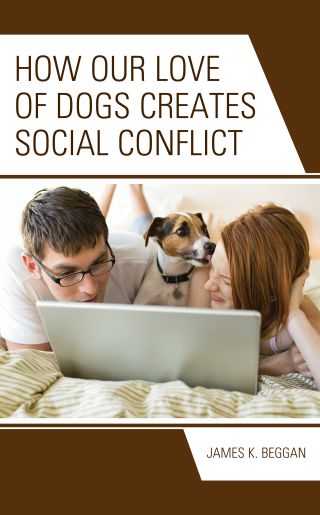Relationships
Can Dogs Intentionally Create Social Conflict?
Might dogs try to disrupt human relationships to further their own interests?
Updated June 19, 2023 Reviewed by Tyler Woods
Key points
- Interspecies triadic relationships, involving two humans and a dog, resemble human triadic relationships.
- Dogs may be active agents of social conflict within a triad.
- Dogs may engage in human conflict escalation to further their own relational interests.
Although dogs are often portrayed as loving and happy-go-lucky members of human families and communities, they are also the root of a good deal of bitterness and anger. Dogs can be a significant source of conflict between neighbors (barking, peeing on lawns), between people in public spaces (running off-leash, approaching people, jumping on them), and between dog owners, as with disagreements generated over varying expectations of what “responsible dog ownership” looks like (one owner conscientiously abides by all leash regulations because she wants to respect the needs of other humans and dogs and be good citizens; another owner takes her dog off-leash at the far end of the park where it is deserted because she feels that it isn’t causing any harm and she feels a responsibility to give her dog the freedom to run and explore).
Dogs are certainly a point of contention within households and between human partners. Disagreements can arise about how to care for the dog (going on a trip and leaving the dog in a kennel might seem fine to one dog parent and like abandonment to the other). A dog can generate jealousy if, for example, they form an especially close bond with one member of the human family and ignore everyone else. A dog can also become a mouthpiece for passive-aggressive communication (“Oh look, Sparky. Somebody forgot to take out the trash. Again.”)
A recently published book by sociologist James K. Beggan, How Our Love of Dogs Creates Social Conflict (Lexington Books) takes an in-depth look at the role dogs play in human social conflict. Beggan's particular interest is in the role dogs play as active, intentional agents of social conflict. He asks a provocative question: Do dogs try to disrupt relationships to gain some advantage?

Dogs and Triads
Much of Beggan’s previous work has focused on human sexual relations, including polyamory. In his new book, he turns attention to the role of dogs within relational triads, which he defines as three individuals who interact on successive occasions. Triads are inherently unstable. Within a triadic romantic relationship, there are often elements of competition, with two individuals sometimes forming a coalition against the third. According to Beggan, pets can also form part of a triad, given the powerful emotional and psychological connection that some people have with their animals. He is especially interested in the potential for conflict within human couples where one of them owns a dog and where the dog becomes allied with one of the humans.
He doesn’t stop at the question of whether dogs can be a point of conflict within a dyadic human relationship. The even more provocative question he poses is this: “Can dogs operate effectively in triads and take advantage of or encourage the potential for conflict among humans?” In other words, are dogs capable of willfully managing, even disrupting, human relationships to further their own interests?
His tentative answer to this question is yes. He offers several lines of evidence, a few of which I’ll mention very briefly.
Dogs Understand Triads
Dogs have the cognitive capacity to be active agents in human conflicts. During play, dogs engage in self-handicapping and role reversal, suggesting that dogs understand the abilities of their play partners and shape their own behavior in response. Dogs build coalitions, acting cooperatively to intimidate a common target. Dogs form friendships, and they engage in conflict reduction techniques (calming signals, consolation, and reconciliation).
Dogs are also adept at social interactions with humans. There is no reason, says Duggan, not to think that dogs could engage in some of these same strategies within a human-human-dog triad.
Perspective Taking
Dogs have well-honed perspective-taking skills and can know what another is thinking, including knowing what humans are thinking. Beggan suggests, with evidence from ethology literature on play, including fellow PT contributor Marc Bekoff’s research, that dogs can take the perspective of other dogs, returning us again to the examples of self-handicapping and role-reversal. Dogs may be even more skilled than we know at gathering and processing information about human emotions and intentions. Dogs can use their perspective-taking ability to get what they want or need from a situation and can, says Beggan, “put their own self-interest ahead of obedience to humans.” (131)
Communication
Dogs are sensitive to human communication and are empathically attuned to us. They're skilled at reading cues from our facial expressions, tone of voice, and perhaps even our odor. And they impart information to us though their vocalizations, facial expressions, and body postures. Being able to understand our emotions and communicate with us would help dogs work cooperatively with us; it would also, says Beggan, give them the means to work against a human, “especially if doing so would strengthen their relationship with a highly valued human, such as a caregiver or owner.” (133)
Other factors that Beggan considers relevant to dogs as agents of conflicts are the canine capacity for jealousy and an aversion to inequity.
Future questions
Although the research into dogs as “agentic catalysts” of conflict is undeveloped, Beggan offers this as a possible area for future research. If dogs engage in conflict escalation as tertius gaudens (“a rejoicing third”; one who benefits when two others are in a dispute) what strategies do they use? Are these strategies effective?
He also suggests that we could use what we learn about the role of dogs in triadic relationships (two human guardians, one pet dog), to think about other social configurations involving dogs and humans. Another question that would be interesting to explore is how best to mediate interspecies conflicts involving dogs and humans.
As the number of dogs living as pets continues to increase, the possibilities for dog-related and dog-generated conflict will continue to rise, and we will need to develop effective ways to think about and respond to this conflict. Beggan’s work is an important contribution to the conversation. It is also important because he asks us to pay more attention to the agential capacities of dogs and other animals.
For Beggan, dogs are not just as objects of social conflict, but also subjects. Not just pawns, but chess players.
References
James K. Beggan, How Our Love of Dogs Creates Social Conflict. Lanham, Maryland: Lexington Books, 2022.




